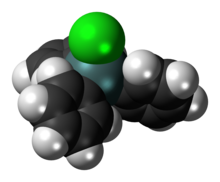Triphenyltin chloride
Appearance

| |

| |
| Names | |
|---|---|
| IUPAC name
chlorotriphenylstannane
| |
| Identifiers | |
3D model (JSmol)
|
|
| ChEMBL | |
| ChemSpider | |
| ECHA InfoCard | 100.010.327 |
PubChem CID
|
|
| UNII | |
CompTox Dashboard (EPA)
|
|
| |
| |
| Properties | |
| C18H15ClSn | |
| Molar mass | 385.4747 g/mol |
| Appearance | colourless solid |
| Melting point | 108 °C (226 °F; 381 K) |
| Boiling point | 240 °C (464 °F; 513 K) |
| organic solvents | |
Except where otherwise noted, data are given for materials in their standard state (at 25 °C [77 °F], 100 kPa).
| |
Triphenyltin chloride is an organotin compound with formula Sn(C6H5)3Cl. It is a colourless solid that dissolves in organic solvents. It slowly reacts with water. The main use for this compound is as a fungicide and antifoulant.[1] Triphenyl tin chloride is used as a chemosterilant. Triphenyl tins used as an antifeedants against potato cutworm.
Hazards
[edit]Triphenyltin chloride is as toxic as hydrogen cyanide.[2] It also caused detrimental effects on body weight, testicular size and structure, and decreased fertility in Holtzmann rats.[3]
References
[edit]- ^ Davies, A. G. (2004). Organotin Chemistry. Weinheim, Germany: Wiley-VCH. ISBN 3-527-31023-1.
- ^ G. G. Graf (2005). "Tin, Tin Alloys, and Tin Compounds". Ullmann's Encyclopedia of Industrial Chemistry. Weinheim: Wiley-VCH. doi:10.1002/14356007.a27_049. ISBN 3527306730.
- ^ Golub, M. S. (2006). Metals, Fertility, and Reproductive Toxicity. CRC Press. pp. 28–31. ISBN 0-415-70040-X.
